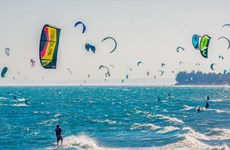Vietnam aims to tap sea tourism potentials
With more than 3,000km of coastline – including dozens of islands and
beautiful beaches – Vietnam should be one of Asia’s top sea tourism
destinations, said the Communist Party of Vietnam (CPV) Online
Newspaper.
With more than 3,000km of coastline – including dozens of islands and
beautiful beaches – Vietnam should be one of Asia’s top sea tourism
destinations, said the Communist Party of Vietnam (CPV) Online
Newspaper.
According to the Vietnam National Administration of Tourism (VNAT), the country has over 100 beaches favourable for tourism development such as Sam Son, Lang Co, Da Nang, Nha Trang, Phan Thiet and Vung Tau. Many coastal provinces and cities such as Hai Phong, Quang Ninh, Hue, Da Nang and Quang Nam are endowed with stunning natural landscapes and the country’s coastal areas as a whole boast over 1,400 hotels and over 45,000 rooms.
But according to Mai Tien Dung, Deputy Director of the Hanoi municipal Department of Culture, Sports and Tourism, sea and island tourism in Vietnam are underdeveloped as the country only exploits a small part of its sea and island resources.
For example, in the north, Hai Phong authorities have focused all their energy on Do Son beach, ignoring other locations, while Quang Ninh has focused mainly on promoting Ha Long Bay without exploiting other destinations. Only recently have strategic tourism programmes begun in Quang Ninh’s Bai Tu Long Bay and Co To Island.
Tourism experts have praised recent moves to make Co To a more popular destination, but they say many necessities are still lacking there.
“Compared to other islands, Co To has a big advantage because it has been connected to the national power grid. However, power still does not reach all locations on the island, including beaches,” said Dung.
“Clean water accommodations still fail to meet standards. Other services such as entertainment and shopping are very limited [on Co To]."
Nguyen Duc Thanh, Chairman of the Co To district People’s Committee, said there are only five passenger ships from the mainland to the island so they are often overloaded.
Tourism human resources and manpower are also lacking. The island district is home to only 30 people trained in tourism at the intermediate and college levels.
Ly Son Island in Quang Ngai province, often called "Vietnam’s Jeju", is in a similar situation as Co To. Currently, the island district has only 12 accommodation establishments with about 80 rooms. Moreover, the island is not connected with the national electricity grid. The island’s lone diesel power plant can only provide power from 5pm to 11pm, an extreme inconvenience for any visitor.
Cruise tourism in Vietnam is also undeveloped because of poor seaport infrastructure, tourism experts said.
Vietnam has no dedicated port for cruise ships and most ports welcoming tourists were built for cargo ships, therefore, cruises have to berth afar and tourists are taken to the mainland by small boats.
According to Nguyen Cong Hoan, Deputy General Director of Hanoi Red Tours, another important reason for Vietnam’s cruise industry woes is that the hotels and resorts at many would-be cruise destinations are simply not big enough to accommodate a ship full of visitors. It’s extremely difficult to find a seaside destination in Vietnam that can provide international standard services to 2-5,000 visitors.
"Tourists from cruise ships are usually luxury tourists so their demands are relatively high compared to the general services at these destinations,” said Hoan.
“When a cruise with about 2-3,000 visitors arrives, there must be 1-2,000 high-quality rooms available. But in the current condition, hotels and resorts in Vietnam have not met the demand. This is one of the reasons that cruise companies are reluctant to take visitors to Vietnam.”
Asia is an attractive destination for cruises thanks to its many modern seaports. Vietnam is easy to access and is connected to modernized international seaport centres such as Hong Kong and Singapore, which serve cruises to Asia. Many famous cruise companies in the world have arrived in Vietnam such as Star Cruises, Phoenix Cruises, Orion Expedition Cruises, Super Star Aquarius. But there are only a few places these ships can visit in Vietnam so far, according to tourism experts.
Analysts say that not investing in cruise tourism development could mean squandering the potential of Vietnam’s natural coastline.
To exploit the strengths and potentials of sea and island tourism in Vietnam, the Government’s project on tourism development with a vision to 2030 includes a strategy to promote sea and island tourism development in the coming years.
It is hoped that when the project is implemented, Vietnam’s target of becoming the nation with the most developed sea tourism in the region will come true in the future.-VNA
According to the Vietnam National Administration of Tourism (VNAT), the country has over 100 beaches favourable for tourism development such as Sam Son, Lang Co, Da Nang, Nha Trang, Phan Thiet and Vung Tau. Many coastal provinces and cities such as Hai Phong, Quang Ninh, Hue, Da Nang and Quang Nam are endowed with stunning natural landscapes and the country’s coastal areas as a whole boast over 1,400 hotels and over 45,000 rooms.
But according to Mai Tien Dung, Deputy Director of the Hanoi municipal Department of Culture, Sports and Tourism, sea and island tourism in Vietnam are underdeveloped as the country only exploits a small part of its sea and island resources.
For example, in the north, Hai Phong authorities have focused all their energy on Do Son beach, ignoring other locations, while Quang Ninh has focused mainly on promoting Ha Long Bay without exploiting other destinations. Only recently have strategic tourism programmes begun in Quang Ninh’s Bai Tu Long Bay and Co To Island.
Tourism experts have praised recent moves to make Co To a more popular destination, but they say many necessities are still lacking there.
“Compared to other islands, Co To has a big advantage because it has been connected to the national power grid. However, power still does not reach all locations on the island, including beaches,” said Dung.
“Clean water accommodations still fail to meet standards. Other services such as entertainment and shopping are very limited [on Co To]."
Nguyen Duc Thanh, Chairman of the Co To district People’s Committee, said there are only five passenger ships from the mainland to the island so they are often overloaded.
Tourism human resources and manpower are also lacking. The island district is home to only 30 people trained in tourism at the intermediate and college levels.
Ly Son Island in Quang Ngai province, often called "Vietnam’s Jeju", is in a similar situation as Co To. Currently, the island district has only 12 accommodation establishments with about 80 rooms. Moreover, the island is not connected with the national electricity grid. The island’s lone diesel power plant can only provide power from 5pm to 11pm, an extreme inconvenience for any visitor.
Cruise tourism in Vietnam is also undeveloped because of poor seaport infrastructure, tourism experts said.
Vietnam has no dedicated port for cruise ships and most ports welcoming tourists were built for cargo ships, therefore, cruises have to berth afar and tourists are taken to the mainland by small boats.
According to Nguyen Cong Hoan, Deputy General Director of Hanoi Red Tours, another important reason for Vietnam’s cruise industry woes is that the hotels and resorts at many would-be cruise destinations are simply not big enough to accommodate a ship full of visitors. It’s extremely difficult to find a seaside destination in Vietnam that can provide international standard services to 2-5,000 visitors.
"Tourists from cruise ships are usually luxury tourists so their demands are relatively high compared to the general services at these destinations,” said Hoan.
“When a cruise with about 2-3,000 visitors arrives, there must be 1-2,000 high-quality rooms available. But in the current condition, hotels and resorts in Vietnam have not met the demand. This is one of the reasons that cruise companies are reluctant to take visitors to Vietnam.”
Asia is an attractive destination for cruises thanks to its many modern seaports. Vietnam is easy to access and is connected to modernized international seaport centres such as Hong Kong and Singapore, which serve cruises to Asia. Many famous cruise companies in the world have arrived in Vietnam such as Star Cruises, Phoenix Cruises, Orion Expedition Cruises, Super Star Aquarius. But there are only a few places these ships can visit in Vietnam so far, according to tourism experts.
Analysts say that not investing in cruise tourism development could mean squandering the potential of Vietnam’s natural coastline.
To exploit the strengths and potentials of sea and island tourism in Vietnam, the Government’s project on tourism development with a vision to 2030 includes a strategy to promote sea and island tourism development in the coming years.
It is hoped that when the project is implemented, Vietnam’s target of becoming the nation with the most developed sea tourism in the region will come true in the future.-VNA













